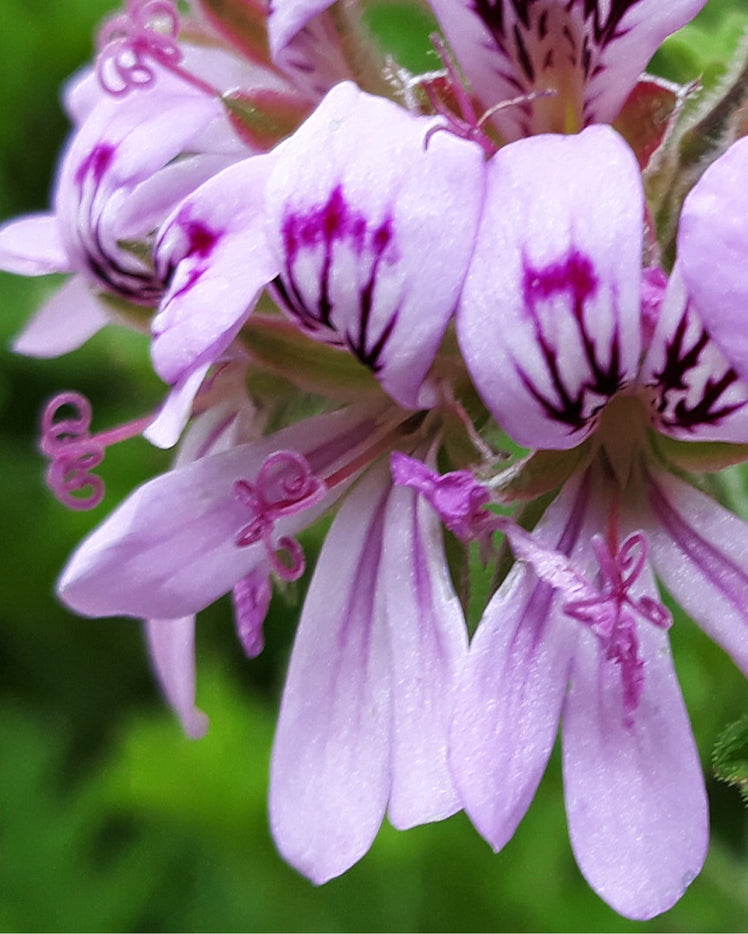About the Oil
Steam-distilled from the aromatic leaves and stems of Pelargonium graveolens, geranium essential oil is cherished for its rosy, floral, and herbaceous aroma. Often considered a botanical harmonizer, it has a long-standing place in skincare, stress support, and hormonal balancing. Its main constituents—citronellol, geraniol, and linalool—contribute to its calming, clarifying, and antimicrobial properties.
Why You Would Use Geranium Essential Oil
-
To promote emotional balance and uplift mood
-
To support skin health, particularly for oily or sensitive skin
-
To ease mild stress and tension
-
To harmonize hormonal shifts and menstrual discomfort
-
To help balance the appearance of sebum production in skincare
Clinical Findings
| Study Focus | Study Design | Key Findings | Reference |
|
Antioxidant properties |
Literature review |
Geranium essential oil showed significant free radical scavenging activity, supporting its protective antioxidant potential |
Ali et al., 2015 |
|
Antimicrobial |
GC-MS |
β-citronellol – antimicrobial, food-protective |
Ghannadi et al.,2012 |
|
Antibacterial potential |
Disc diffusion and MIC assays |
Effective against a variety of Gram-positive and Gram-negative bacteria including S. aureus and E. coli |
Khouya et al., 2015 |
Behind The Science
Geranium essential oil exerts its effects largely due to its rich monoterpene and alcohol content, particularly citronellol and geraniol. These compounds have been shown to interact with neurotransmitter systems like GABA, which may explain its relaxing and mood-lifting properties.
Additionally, its antimicrobial power is attributed to its ability to disrupt bacterial cell membranes, making it beneficial for topical use and natural purification. When inhaled or applied, it may also help regulate cortisol levels, promoting a more balanced stress response.
How and Where It Grows
Pelargonium graveolens is native to southern Africa but is now cultivated globally, particularly in Egypt, Reunion Island, and India for essential oil production. The oil is obtained through steam distillation of its leaves and stems, which contain fragrant oil glands that capture the plant’s therapeutic essence.
Use in Ancient Medicine
Though the use of geranium as an essential oil is more modern, the plant itself has traditional roots in South African and Ayurvedic herbal medicine. It was used for treating wounds, gastrointestinal issues, and infections. In aromatherapy, geranium evolved as a key oil for emotional grounding and energetic restoration.
Symbolism
Geranium symbolizes emotional steadiness and healing. Its scent is often associated with heart-centered energy, encouraging love, trust, and the restoration of personal boundaries. Used in rituals of protection and balance, it represents the alignment of body, mind, and spirit.
INFORMATION provided is intended for informational purposes only and is not meant to diagnose, treat, cure, or prevent any disease. Statements have not been evaluated by Health Canada or the FDA. Please consult a qualified healthcare provider before using essential oils for therapeutic purposes.
References
- Babar Ali, Naser Ali Al-Wabel, Saiba Shams, Aftab Ahamad, Shah Alam Khan, Firoz Anwar, Essential oils used in aromatherapy: A systemic review Asian Pacific Journal of Tropical Biomedicine Volume 5, Issue 8 (2015) Pages 601-611
- Tisserand, R., & Young, R. (2014). Essential Oil Safety: A Guide for Health Care Professionals (2nd ed.). Churchill Livingstone Elsevier.
- Ghannadi, A., Bagherinejad, M., Abedi, D., Jalali, M., Absalan, B., & Sadeghi, N. (2012). Antibacterial activity and composition of essential oils from Pelargonium graveolens L'Her and Vitex agnus-castus L. Iranian journal of microbiology, 4(4), 171–176.
- Boukhris, Maher & Bouaziz, Mohamed & Feki, Ines & Jemai, Hedya & El Feki, Abdelfattah & Sayadi, Sami. (2012). Hypoglycemic and antioxidant effects of leaf essential oil of Pelargonium graveolens L’Hér. in alloxan induced diabetic rats. Lipids in health and disease. 11. 81. 10.1186/1476-511X-11-81.
- Khouya, T., et al. (2015). Chemical composition and antimicrobial activities of essential oil of Pelargonium graveolens cultivated in Morocco. Journal of Essential Oil Research,

